Thornless and resistant variety of black gooseberry “African”
Many gardeners value gooseberries very much, but do not want to grow them due to difficulties during harvesting. There is hardly a person who likes to scratch their hands on thorns. But breeders have long since solved this problem by creating thornless varieties. African is one of the brightest representatives of such plants.
What kind of gooseberry is this?
African is a mid-season gooseberry variety that has gained popularity among gardeners due to its unusual appearance, strong immunity to disease, ease of care and good taste of the berries.
The variety was bred by specialists from the Saratov Horticulture Experimental Station in 1971. Suitable for cultivation in almost all regions of Russia.
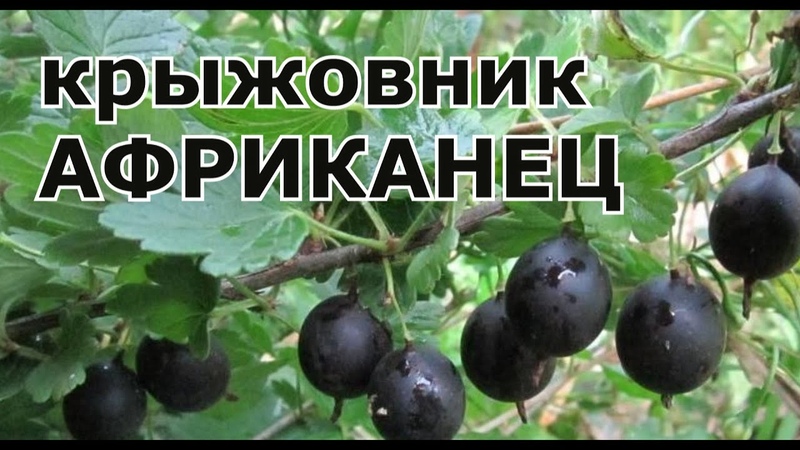
African gooseberry: characteristics and description of bushes
This unpretentious variety does not require special skills and knowledge to grow and harvest a good harvest.
Important! Culture doesn't need varieties-pollinators, since it is self-fertile.
The variety is distinguished by large fruits and high yield. Compact bushes do not take up much space on the site.
Temperature resistance
African gooseberry tolerates frosts down to -40°C. The root system is not damaged in such harsh conditions. However, if you cover it carelessly for the winter, there is a chance that the shoots will freeze.
Moisture and drought resistance
During prolonged drought, the fruits become smaller, so it is important to organize watering during such periods. Then the berries will be juicy and large.
Excessive moisture also negatively affects the plant.When water stagnates, the root system begins to rot.
Resistance to diseases and pests
The African is resistant to various pests and fungal diseases, but is susceptible to anthracnose. This disease spreads very quickly to neighboring bushes and appears as reddish spots on the foliage.
Characteristics and description of African gooseberry fruits
The berries are medium-sized, weighing about 2.5 g, slightly elongated or round, slightly pubescent, with a strong waxy coating. The color is black, the peel is dense, so the fruits tolerate long-term transportation and practically do not lose their taste after freezing. The taste is sweet and sour, there is a faint aftertaste of black currant.
On average, up to 5-6 kg of fruits are removed from an adult plant. This variety produces its first harvest a year after planting.
Areas of use
The berries are used to make jam, marmalade, compotes, jams, wine, juice, they are added to baked goods and various desserts, and eaten fresh.
The pulp has strong coloring properties, so it is used in the food industry as a natural coloring agent.
Advantages and disadvantages
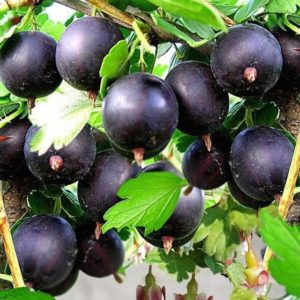
The African has many advantages:
- good taste of fruits;
- high productivity;
- self-fertility;
- absence of thorns;
- resistance to harsh winters;
- strong immunity to fungal diseases.
Among the disadvantages, the only highlight is that gooseberries are susceptible to anthracnose.
Growing technology
To grow gooseberries, it is important to choose a place on the site and the optimal planting time.
Optimal conditions
The place for culture must meet the following requirements:
- the site is located on a hill to prevent stagnation of water;
- the place is well lit, protected from strong winds and drafts;
- the minimum depth of groundwater is 1.5 m;
- the most suitable soil is loam or sandy loam.
Landing dates and rules
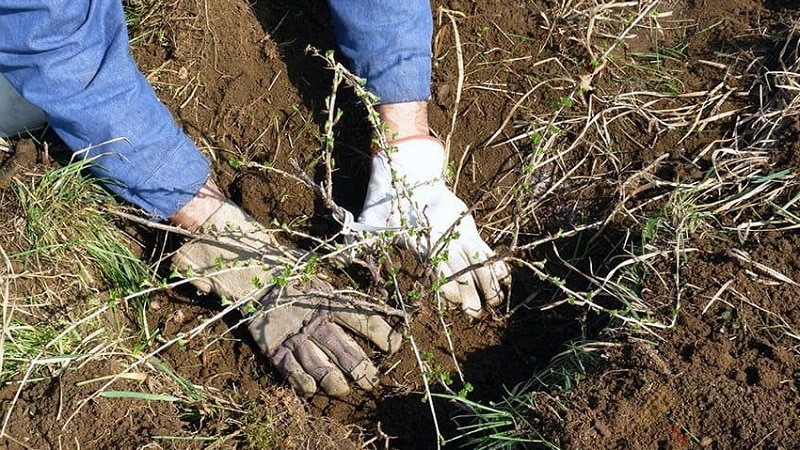
Gooseberry planting begins in the fall or spring. The best period is considered to be autumn, approximately 1–1.5 months before the first frost: at this time the root system is well developed and saturated with useful substances.
Spring is a less favorable period, since the buds on the bushes bloom very early. If gooseberries are planted at the wrong time, they may get sick. This will have a bad effect on the quantity and quality of the harvest.
When choosing planting material, it is important to consider the following factors:
- seedlings age - 1 or 2 years;
- roots are strong and developed;
- It is better to buy plants in specialized nurseries or from trusted suppliers.
Rules for planting African gooseberries:
- Thoroughly clear the place for constant growth of weeds and dig up the soil.
- Prepare the planting hole. Its diameter should be 50–60 cm and its depth 40 cm.
- Mix 50 g of superphosphate, 300 g of sifted wood ash and a bucket of rotted manure with the soil.
- Dilute 1 tbsp in 5 liters of water. l. potassium humate. Soak the roots of the seedlings in this solution to stimulate root formation. The drug "Kornevin" is also suitable. It is used in accordance with the instructions indicated on the package.
- Trim damaged and dry roots.
- Make a mound from the prepared soil mixture at the bottom of the planting hole. Place the plant on it and distribute the roots evenly to the sides. Cover with soil and tamp down a little. The root collar should be deepened into the ground by 5–7 cm.
- Trim the branches, leaving 3–5 buds on each.
- Water the bush: 1 bucket of water is enough for each plant.
- Mulch the tree trunk with straw, pine needles or humus.The mulch layer should be at least 5 cm.
The bushes are planted at a distance of 1 m from each other. The gap between the rows is from 1.5 m.
Further care
Crop care activities boil down to maintaining good soil condition, loosening and removing weeds, fertilizing, regular watering and pruning. It is important to carry out preventive treatment against pests and diseases.
Loosening and watering
Soil care steps:
- After the snow melts (in early spring), loosen the area well so that the roots receive fresh air.
- Loosening should be carried out at least 4 times during the season.
- Water each bush regularly (10–20 liters of water), but make sure that the water does not stagnate.
- After each watering, mulch the tree trunk circles to retain moisture in the soil and prevent weeds from germinating.
Feeding
Gooseberries are fed several times:
- In the first year after planting, the bushes are not fed, since fertilizers were placed in the planting hole.
- In the spring, before sap flow begins, liquid nitrogen fertilizers are applied (1 tablespoon of ammonium sulfate is dissolved in 10 liters of water).
- Before flowering, plants are fed with organic means: a solution of horse or cow manure.
- At the very beginning of fruiting, a solution of ammonium nitrate (20 g of substance per 10 liters of water) is added under each bush.
- After harvest add 35 g of potassium chloride, 60 g of superphosphate and 6 kg of humus.
Installation of support
If the branches sink to the ground, the berries on the bushes begin to rot. To prevent this, gardeners tie the gooseberries to a support. To do this, drive 3 pegs around the bush and connect them together with wire or thin strips. The branches are attached to the horizontal part of the support.
Gooseberry branches should not be allowed to come into contact with the ground, as this often leads to infection with various infections.
Trimming
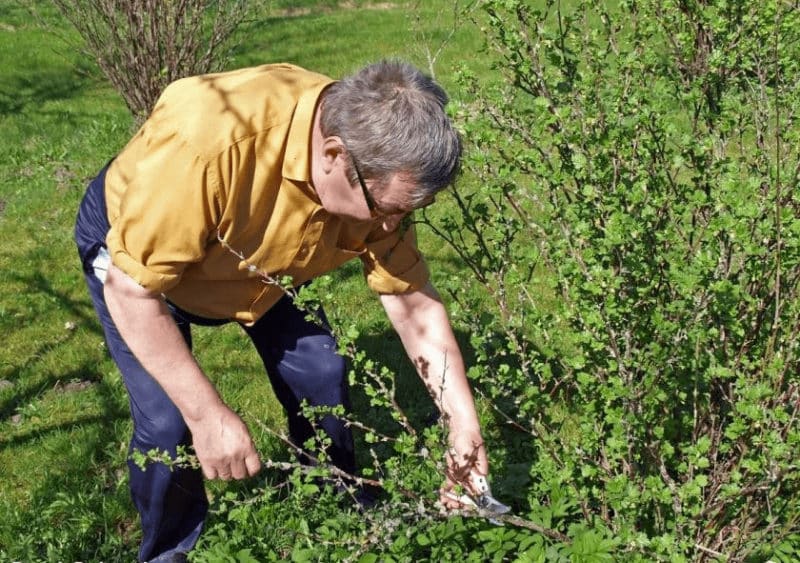
The African variety produces new shoots every year. This gradually leads to excessive thickening of the bushes, which greatly reduces the yield. Therefore, it is important to prune every season, starting from the second year after planting.
Advice! Drooping and old branches are cut off, and young ones are shortened so that the cut is above the bud itself. This will allow new shoots to grow upward rather than sideways.
3-4 of the strongest and most developed annual shoots are left on the young bush. An adult plant has 14 shoots of different ages.
Possible problems, diseases, pests
To prevent the development of diseases and the appearance of pests in the spring, the bushes are treated with 1% Bordeaux mixture. The plants are sprayed a second time a week after harvest.
African is resistant to most diseases and pests, so it is grown with minimal use of chemicals.
Wintering
The African variety tolerates severe frosts well, but requires some preparation for winter:
- After the leaves fall, remove all plant debris from the area.
- Dig up the ground around the bushes, pour in several buckets of water.
- For each plant add 1 kg of humus and 100 g of wood ash.
- Carry out sanitary pruning. Remove all diseased and dry shoots.
- Mulch the ground with a layer of peat or humus of at least 10 cm.
Reproduction
Methods for propagating gooseberries:
- Cuttings. In June, select the most powerful and healthy stem, cut it and divide it into 20 cm pieces. Soak one end in the Kornevin solution and plant it in a box with a nutritious substrate of peat and garden soil.Place the box in the greenhouse; Make sure that the substrate is always damp. Replant to a permanent location in the fall.
- Dividing the bush. Dig up the bush and divide it into several parts, which are planted separately.
- By layering. Bury young shoots to a depth of 10–15 cm. Wait until roots form, keeping the soil moist. After the formation of its own roots, separate the shoot from the mother plant.
Features of cultivation depending on the region
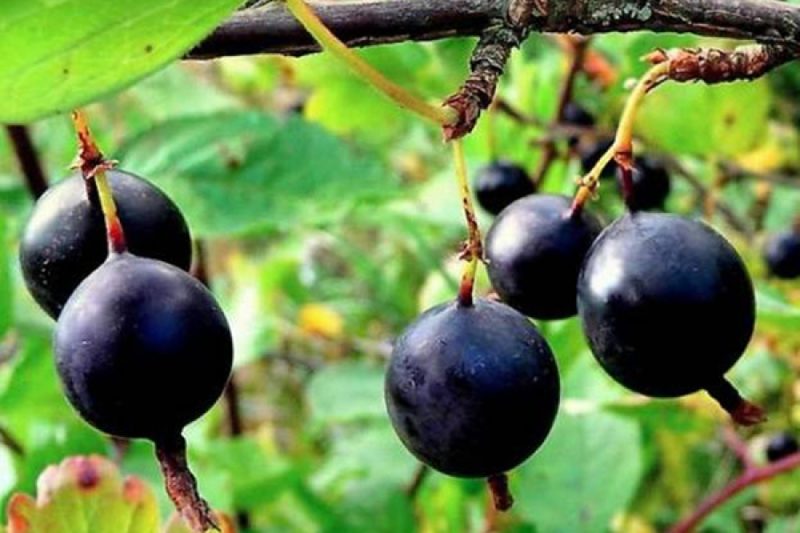
In the northern regions, gooseberries are planted in early September. In the middle zone, planting is carried out from late September to mid-October, in the southern regions - in early or mid-November. The main thing is to have time to plant the bush no later than 1 month before the arrival of frost.
In regions where the temperature drops below -30°C, the bush is covered with agrofibre.
Reviews from summer residents
Gardeners note the variety's unpretentiousness, immunity and taste of berries.
Evgeniy Petrovich, Ekaterinburg: “I have been growing African gooseberries for a very long time. Not only does it not have thorns, but during this time I have never seen the bushes hurt. Plants are not affected and aphid. They tolerate winters well: for 15 years there has not been a single case of shoots freezing. Every year I reap a bountiful harvest.”
Ekaterina Ivanovna, Sochi: “I think the main advantage of the African is not the absence of thorns, but its good resistance to powdery mildew. Other varieties are often affected by it, but this gooseberry has never been affected for many years. Of course, I carry out preventive treatments, but I think the bushes would feel good even without them.”
Irina Vasilievna, Khabarovsk: “My husband sometimes makes wine from these gooseberries, and every year I make jam for the winter. The taste of the berries is very rich and pleasant, a little reminiscent of black currants».
Conclusion
African gooseberry is an old variety that gardeners like for its large fruits, unpretentiousness, disease resistance and abundant harvests. The main thing is to feed the plants on time, water them and do pruning so that the berries do not become smaller. Compact bushes do not take up much space in the garden, and the fruits make delicious jam, jam and wine.